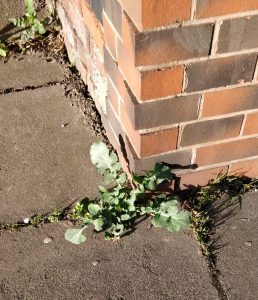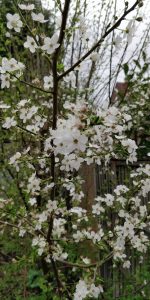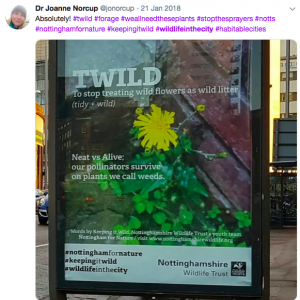“ Spring is here … and they can’t stop you enjoying it. This is a satisfying reflection. How many a time have I stood watching the toads mating, or a pair of hares having a boxing match in the young corn, and thought of all the important persons who would stop me enjoying this if they could. But luckily they can’t. So long as you are not actually ill, hungry, frightened or immured in a prison or a holiday camp, Spring is still Spring. The atom bombs are piling up in the factories, the police are prowling through the cities, the lies are streaming from the loudspeakers, but the earth is still going round the sun, and neither the dictators nor the bureaucrats, deeply as they disapprove of the process, are able to prevent it
George Orwell (1946) Some Thoughts On The Common Toad.
Spring. The utter joy of it. Wandering Beeston, there are signs of its hopeful presence everywhere. All you need to do is slow down or stop and get your senses tuned in: look for the first buds, listen for increased birdsong, smell the first blossoms, watch nature return to our gardens and parks, the street trees, in the cracks in the pavement and the near smiles on folks faces when the sky happens to be blue and the sun is out. It is such a glorious season, full of the promise of new life and possibilities.
Along the railway tracks, the Wild Cherry and Hawthorn have begun to blossom, and the Apple, Elder, and Silver Birches have begun to bud. These route-ways offer shelter, sustenance, and respite for diverse animal life that migrate along them including the humans who wend their daily commute, looking out of carriage windows beyond a phone or computer screen.
This Trees Of Beeston piece is a broader reflection on how our ‘green corridors’: the plants in our locality, synergise, connect, and facilitate Spring to, well, spring. It considers how we might, with a little planning, tune into the seasons, tweak our garden maintenance patterns to ensure spring keeps returning, and to value those ‘out of place’ plants that assist Beeston’s flourishing biodiversity.
A huge number of hedgerows have been ‘lost’ across the country in recent years, especially in the back gardens of urban settlements. Recent social media coverage of netted hedges and trees to stop birds nesting and examples of extreme ‘pruning’ is surely a sign of the meanest of human spirits. So this column reminds readers of what to do when rapid growth of vegetation in trees and bushes can make them ‘look’ untidy, and when humans, venturing back out into their gardens wish to ‘tidy things up’ ready for summer socialising and BBQing
So what to do? Advice from the RSPB (Royal Society for the Protection of Birds) regarding hedgelaw is that between March and August there should be no cutting as this is the prime time period in which birds are making their nests, rearing their young and when their young are fledging. The RSPB website states:
“It is a criminal offence under Section 1 of the Wildlife and Countryside Act of 1981 to intentionally take, damage, or destroy the nest of any wild bird while it is in use or being build, or to intentionally kill, injure or take chicks or adults, or intentionally take or destroy any eggs. It is an intentional act, for example, if you or your neighbour know there is an active nest in the hedge and still cut the hedge, damaging or destroying the nest or contents in the process”
The RSPB recommend if you know someone is cutting a hedge during this period to:
“… speak to them and politely mention the risk to the birds’ nests, and the laws protecting nests. If they proceed, and you know there is an active nest at risk, contact the police on 101, and ask for a reference number. If you are unsure what to do, contact RSPB Wildlife Enquiries on 01767 693690.”
When it comes to dealing jointly with neighbours regarding a boundary hedge or trees, the RSPB advises:
“Disagreements with neighbours often relate to the size and tidiness of the hedge and about cutting the hedge, particularly during the breeding season. A boundary hedge is usually the joint responsibility of both neighbours. Both must agree on major work, including removal, coppicing or laying. In theory, you need your neighbours’ agreement even before trimming the hedge. If the hedge is just inside your neighbours’ garden, they own it. You only have the right to trim any part which encroaches over your boundary line. Your neighbour should ask for your permission for access to trim the hedge on your property. Regardless of ownership, no-one can trim or cut a hedge if the action damages active birds’ nests, and hence violates the Wildlife and Countryside Act. If tall hedges or trees put your garden in the shade, you can cut off branches which overhang your boundary. You can also prune back roots that invade your property, even if this is detrimental to the plant. You do not have the right to cut down vegetation on your neighbours’ property, or apply weedkiller to destroy the plants.”
If door to door ‘tree surgeons’ call between March and August offering to cut down your trees, politely remind them that birds might be nesting. By all means, maintain your trees/border plants. Plan to prune / cut back trees in the winter months when they are dormant and when birds are not nesting (between November and January), but for now, leave the hedges for the nesting birds.
Love Your Weeds.
From hedgerow to cracks in the pavement. I know that many people dislikes “weeds” or the socially maligned wild plants that manage to survive in the harshest of conditions: in the cracks in paving, along verges, in the cracks of buildings (oh Buddleia, how do you manage it?). These plants offer sustenance to pollinating insects and provide the possibility of food for animals and humans alike (look at this lovely wild cabbage growing along Woollaton Road!).

Wild cabbage growing out of cracks in the pavement on the corner of the Methodist church, Woollaton Road.
The dandelion should be celebrated: its tender young leaves can be eaten like rocket, and the roots were used to make coffee substitute during World War 2. In these stricken ‘austerity’ times, many ‘weeds’ offer food and medicinal possibilities for animals and humans alike (Disclaimer: only ever eat plants you absolutely know are non-poisonous and are in suitable locations to ensure your own health isn’t compromised. Look up foraging and wild foods books in our fabulous Beeston Library. I would recommend Richard Mabey’s classic Food For Free). So please consider doing some exercise (or get someone else to do the exercise) and physically weed these plants you want to remove rather than using weedkiller. Ideally remove them once they have flowered so the insects can thrive. Please don’t spray weedkiller. Nothing is sadder than shrivelled plants that were once food for pollinating insects (butterflies, bees) or offered scavenging possibilities for the birdlife of Beeston (you only need to see the joy of the Pied Wagtails near Beeston interchange in the carpark/space where once Beeston Fire Station was to see their collective joys, calling to one another and feeding).
In 2018, Nottinghamshire Wildlife Trust began a campaign, Nottingham For Nature, focusing attention on valuing wildlife in the city and its importance for keeping cities and urban habitats (Urbitats) habitable for humans, so humans have to do what they can to ensure space is created and maintained for plants and animals to thrive too. Their #WildlifeInTheCity hashtag gives more information on how to get involved.
I started my column with George Orwell’s quote about Spring. Orwell wrote his essay in 1946, post war, after a harsh winter, when austerity was at its most acute. Hope is very much needed, and ‘austerity’ in 2019 is harsh indeed. The plant and animal lives in our neighbourhood offer us so much. In order that spring can keep springing back, please consider doing your bit, where you can, to ensure the green corridors of Beeston thrive.
Dr JN
Refs:
Mabey, R (1972) Food For Free. Collins (also Collins Gem editions for handy pocket-sized guide).
For more details on ‘pests’ in the garden, see Nottinghamshire Wildlife Trust https://www.nottinghamshirewildlife.org/get-involved/how-you-can-get-involved/wildlife-gardening/pest-or-guest For more details about their #NottinghamForNature campaign, see https://www.nottinghamshirewildlife.org/nottingham-nature
Orwell, G (1946) Some Thoughts On The Common Toad. See https://www.orwellfoundation.com/the-orwell-foundation/orwell/essays-and-other-works/some-thoughts-on-the-common-toad/

